To manage knee osteoarthritis (OA) and related pain, clinical guidelines recommend exercise. But its benefits can be short-lived, due to suboptimal adherence to the prescribed program. Patients and physicians have noted the need for better support to assist patients in maintaining an exercise program on their own. And adherence to such programs has been linked to positive clinical outcomes for knee OA. To meet this need, health coaching by telephone is increasingly being used to assist in chronic disease self-management, with the goals of improving adherence to physiotherapist-prescribed treatments and facilitating health behavioral changes.
In their most recent study published in the January 2017 issue of Arthritis Care & Research, Kim L. Bennell, MD, and colleagues from the University of Melbourne (Australia), Centre for Health, Exercise and Sports Medicine examined the effect of adding health coaching to a home-based physical activity program to improve adherence—thus, improving the clinical effectiveness of the program by decreasing pain and increasing physical function in patients with knee OA.
In this two-arm, parallel-design randomized controlled trial, 168 patients with knee OA were assigned to receive either physiotherapy (n=84) or physiotherapy plus coaching (n=84). All participants had five consultations with a physiotherapist over six months, receiving education and advice on home exercise and physical activity.
During the same six months, the physiotherapy plus couching group received six telephone coaching sessions from clinicians trained in behavioral-change support for exercise and physical activity. These participants could opt to receive six additional coaching sessions—for a total of 12 sessions.
“The coaching intervention used HealthChange … The approach draws on techniques used in motivational interviewing, solution-focused counseling and cognitive behavioral therapy,” write the authors. It also addresses components of facilitating behavioral change, such as effective information exchange, assistance in forming a behavioral goal intention and support in converting the intention into action and maintenance.
Although goals were individualized, the average target recommendations for physical activity were 30 minutes of moderate-intensity physical activity, in bouts of 10 minutes or longer on most days, and 10,000 steps per day. The primary outcomes for pain (Numeric Rating Scale [NRS]) and physical function (Western Ontario and McMaster Universities Osteoarthritis Index [WOMAC]) were measured at six, 12 and 18 months.
The Results
“The addition of simultaneous telephone coaching targeting physical activity and exercise adherence did not augment the clinically relevant pain and function benefits of a physiotherapist-prescribed program alone in people with knee OA,” write the authors in their discussion. “This was despite most self-reported outcomes related to adherence favoring coaching at six months.”
At six months, the primary outcome showed no significant differences in the change in average pain (mean difference 0.4 unit [95% (confidence interval [CI]) 20.4, 1.3]) or physical function (WOMAC: 1.8 units [95% CI 21.9, 5.5]) between the two groups. However, both groups did show clinically relevant improvements from baseline. “These improvements were generally maintained over 18 months,” write the authors. “Improvements at this time point were of an order of magnitude of 42–54% for function, which far exceeds the minimum clinically important difference [MCID] in both groups, and 26–36% for pain, attaining the MCID only in the physiotherapy plus coaching group.”
For secondary outcomes, there were no between-group differences for changes in NRS walking pain, WOMAC pain or quality of life scores at any time point. Although some secondary outcomes related to physical activity and exercise behavior favored the physiotherapy plus coaching group at six months, this difference was not significant at 12 or 18 months.
Adherence: Participants in the physiotherapy plus coaching group had greater adherence during the six-month intervention than the physiotherapy-only group (mean 69% [95% CI 63, 75] vs. mean 55% [95% CI 47, 63]). However, this difference was not maintained at 12 and 18 months. During the intervention, self-rated home exercise adherence using NRS was also higher in the physiotherapy plus coaching group than in the physiotherapy-only group (mean 7.4 [95% CI 6.9, 7.8] vs. mean 5.7 [95% CI 4.9, 6.4]). But again, this difference was not maintained at 12 and 18 months.
In their discussion, researchers note, “The adherence levels needed to affect pain and function are unknown … and greater differences in adherence [between the groups] may be required.” The researchers also suggest that health coaching may be more effective if it begins after physiotherapy visits stop, which is when adherence levels fell to approximately 40%.
Bennell KL, Campbell PK, Egerton T, et al. Telephone coaching to enhance a home-based physical activity program for knee osteoarthritis: A randomized clinical trial. Arthritis Care Res (Hoboken). 2017 Jan;69(1):84–94. doi: 10.1002/acr.22915.


